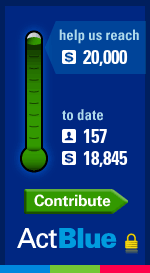Trump Would be America’s Hitler
-by Harvey Wasserman
As The Donald unleashes his inner Adolf, there must be no illusions about what we face.
Through his COVID/drug-induced madness (like Hitler's addiction to crystal meth) Trump’s White Supremacism incites his violent fascist cadres. It’s all a terrifying re-run of Adolf’s rise to power in 1933 Germany.
The terror is escalating at the voting centers, inside and out. The Brown Shirts have blocked voter access at Alexandria, Virginia. Inside they pitch ballots on whatever pretext they can find.
This is the most critical juncture of the election-- where an election board decides whether to disallow mailed-in ballots.
Prepare to see them gather when the votes are counted.
Trump’s fascist rhetoric has sunk to a whole new level in demanding the arrest of his electoral opponent, Joe Biden. No other major party candidate has done that, not even Dick Nixon. Given AG Barr’s sycophantic contempt for the rule of law, take this threat at face value. Terrified of any strong woman of color, Trump has called VP candidate Senator Kamala Harris (D-CA) a “monster.”
Yelling at right-wing militia groups to “liberate Michigan,” he’s got nothing to say about the armed fascist alleged plan kidnap duly-elected governor Gretchen Whitmer. Got that? Kidnap the Governor of a major state!!
At the Mexican border, stealth sterilizations mirror what Hitler did to Jewish, Roma, and eastern European women.
Many of these refugees have come here fleeing Latin American dictatorships installed and maintained by US forces. Some are U.S. citizens. Their children are held in cages.
All face Trump's COVID. None will get anything resembling his multi-million-dollar medical care we pay for. Death and disease rates are state secrets.
Hidden from the public and media, those who’ve seen the camps compare them compare them to Dachau, Bergen-Belsen, and other Nazi concentration camps.
Journalists, labor organizers, feminists, LGBTQ individuals, and progressive activists might remember that Hitler used such camps to “settle scores” once he consolidated power, a virtual inevitability with Barr by Trump’s side.
Like his racist, anti-semitic, Klan-lovting father, The Donald openly touts the “good genes” of his white followers. He attacks African-American, Mexican-American, and other citizens and immigrants of color as “murderers” and “rapists.”
Trump openly lauds Hitler's “racehorse theory,” arguing that human beings can be selectively bred like animals to produce a Master Race.
Here’s what Trump seig-heiled to a virtually all-white crowd in Bemidji, Minnesota, on September 18:
“You have good genes, you know that, right? ou have good genes. A lot of it is about the genes, isn’t it? Don’t you believe? The racehorse theory. You think we’re so different? You have good genes in Minnesota.”
Says Rabbi Mark Diamond, a senior lecturer on Jewish studies at Loyola Marymount University: “To hear these remarks said at a rally in an election campaign for the presidency is beyond reprehensible...
“This is at the heart of Nazi ideology. This has brought so much tragedy and destruction to the Jewish people and to others. It’s actually hard to believe in 2020 we have to revisit these very dangerous theories.”
At Trump’s core is contempt for what Hitler called “Jewish values”: compassion, empathy, remorse-- democracy itself. As reported by his longtime personal attorney Michael Cohen, Trump thinks such beliefs (like science) are for “losers” and “suckers.” “You’re brutal people, not nice people at all,” he once told a room full of Israel supporters, referring to how Jews allegedly do business.
Trump’s backers love his ties to Jews like Cohen; his mobster mentor Roy Cohn; his son-in-law and fellow real estate grifter, Jared Kushner; consigliere Stephen Miller; and mega-backer Sheldon Adelson. His daughter has converted to Judaism, they say. His grandchildren are technically Jewish.
They might remember that Hitler personally signed waivers saving at least 77 Jewish officers who were useful to him while serving in the Nazi Army. Then he exterminated many of their families.
Some still dismiss Trump as a mere Mussolini, calling him a “clown,” as did many American journalists when they first encountered Hitler.
They ignore his utter lack of care for the 220,000-plus Americans who’ve died from his denial of the deadly realities of the coronavirus.
Trump’s hard-core followers suffer no such delusions. They proudly flaunt their swastika flags and Nazi tattoos. They happily salute him as der Fuhrer and loudly hate both Jews and people of color.
These are the “fine people,” who killed Heather Heyer in Charlottesville. This is the “hero” 17-year-old who killed two peaceful demonstrators in Wisconsin (imagine if that kid had been black, how quickly the cops would’ve shot him to pieces, and what Trump would be saying about him now).
Now he’s urged his Proud Boy storm troopers to “stand back and stand by” in anticipation of a coming coup.
Approaching humankind’s most consequential election since 1933, Yale historian Timothy Snyder warns: “That the next atrocity will be different than the last one is not a reason to let it happen. It will be ours, and we have been warned.”
Our Election Protection campaign has become a terminal life/death struggle for our nation and our species.
It will take every ounce of our collective solidarity and strength to defeat Trump’s Hitlerian madness. Our survival demands we shed all illusions about what we face.
Never Again!!
-------------
Harvey Wasserman co-convenes the Grassroots Election Protection Coalition Monday zoom (www.grassrootsep.org). His California Solartopia broadcasts at KPFK/Pacifica 90.7 fm Los Angeles; Green Power & Wellness podcasts at prn.fm. His People’s Spiral of US History awaits Trump’s departure at www.solartopia.org.
Labels: anti-Semitism, Fascists, Harvey Wasserman, racism






























